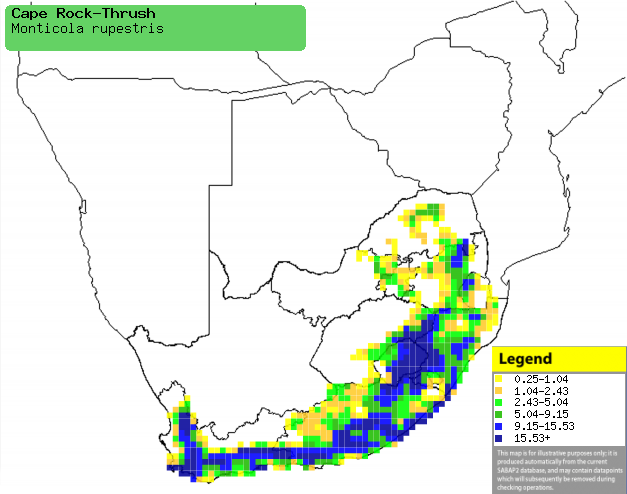|
Monticola rupestris (Cape rock-thrush)
Kaapse kliplyster [Afrikaans]; Igwagwa, Unomaweni [Xhosa];
iKhwelematsheni, isiHlalamatsheni [Zulu]; Thume (generic term for rock
thrush) [South Sotho]; Kaapse rotslijster [Dutch]; Monticole rocar
[French]; Klippenrötel [German]; Melro-das-rochas do Cabo [Portuguese]
Life
> Eukaryotes >
Opisthokonta
> Metazoa (animals) >
Bilateria >
Deuterostomia > Chordata >
Craniata > Vertebrata (vertebrates) > Gnathostomata (jawed
vertebrates) > Teleostomi (teleost fish) > Osteichthyes (bony fish) > Class:
Sarcopterygii (lobe-finned
fish) > Stegocephalia (terrestrial
vertebrates) > Tetrapoda
(four-legged vertebrates) > Reptiliomorpha > Amniota >
Reptilia (reptiles) >
Romeriida > Diapsida > Archosauromorpha > Archosauria >
Dinosauria
(dinosaurs) > Saurischia > Theropoda (bipedal predatory dinosaurs) >
Coelurosauria > Maniraptora > Aves
(birds) > Order: Passeriformes
> Family: Muscicapidae > Genus: Monticola
Distribution and habitat
Endemic to South Africa, Swaziland and Lesotho, generally
preferring cliffs, rocky valleys, boulder-strewn hillsides and scree slopes,
especially with scattered trees, bushes and succulents (such as Aloe and
Euphorbia). It also occupies villages and towns adjacent to these
habitats.
|
 |
|
Distribution of Cape rock-thrush in southern Africa,
based on statistical smoothing of the records from first SA Bird Atlas
Project (©
Animal Demography unit, University of
Cape Town; smoothing by Birgit Erni and Francesca Little). Colours range
from dark blue (most common) through to yellow (least common).
See here for the latest distribution
from the SABAP2. |
Brood parasites
It has been recorded as host of the
Lesser honeyguide and
Red-chested cuckoo.
Food
It mainly eats arthropods, fruit and seeds, doing most of
its foraging on the ground within vegetation or between rocks. The following food items have been recorded
in its diet:
- Invertebrates
- Frogs
-
Trachylepis variegata (Variegated skink)
- Plants
- fruit
- seeds
- nectar of Aloe ferox (Bitter aloe)
Breeding
- Monogamous, solitary nester, with the male vigorously defending his
territory against both other males and other species. It has even been
observed chasing and attacking another male which dared wander into its
territory.
- The nest is a messy platform built of twigs, grass, roots and soil, with
a cup-shaped cavity set into the top. It is typically placed in a rock
crevice or on the ledge of a cliff or building, sometimes reusing the same
nest over multiple breeding seasons.
- Egg-laying season is from September-February, peaking from
September-December.
- It lays 2-4 eggs, which are mainly incubated by the female for about
14-16 days.
- The chicks are fed by both parents on a diet of arthropods, leaving the
nest after about 16 days and becoming fully independent about 10 days later.
Threats
Not threatened.
References
-
Hockey PAR, Dean WRJ and Ryan PG 2005. Roberts
- Birds of southern Africa, VIIth ed. The Trustees of the John Voelcker
Bird Book Fund, Cape Town.
|
